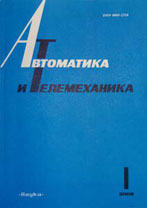|
Control in Technical Systems
Developing an adaptive soft sensor using a predictive filter for a nonstationary process
V. V. Klimchenko, O. Yu. Snegirev, S. A. Shevlyagina, A. Yu. Torgashov
Institute of Automation and Control Processes, Far East Branch, Russian Academy of Sciences,
Vladivostok, 690041 Russia
Abstract:
We propose a procedure for developing an adaptive soft sensor using the example of an analyzer for a nonstationary mass-exchange process. The accuracy of the process output prediction is maximized (mean square error is minimized) by the process model error prediction, which is used as a correction to the process performance estimate. In the case of measurements of process characteristics equidistant in time, a measure of the proximity of the error spectrum distribution to the uniform distribution is used as an adaptation criterion. Such a criterion is essentially a “measure of proximity” of the process model to the optimal one. The advantage of the proposed criterion in comparison with the traditional ones, which measure the characteristics of the error spread, is that changes in the characteristics of the error spread of the model can be caused by reasons not related to the adequacy of the model. With nonequidistant measurements, the amplitudes of the harmonic components of the process are found, which permits one to reconstruct the values of the process characteristics at equidistant points in time using the inverse Fourier transform. In contrast to the traditionally used interpolation, this approach does not distort the spectrum of the process under consideration.
Keywords:
soft sensor, identification, adaptation, reactive distillation process, Kolmogorov criterion.
Citation:
V. V. Klimchenko, O. Yu. Snegirev, S. A. Shevlyagina, A. Yu. Torgashov, “Developing an adaptive soft sensor using a predictive filter for a nonstationary process”, Avtomat. i Telemekh., 2022, no. 12, 141–155; Autom. Remote Control, 83:12 (2022), 1984–1994
Linking options:
https://www.mathnet.ru/eng/at15894 https://www.mathnet.ru/eng/at/y2022/i12/p141
|

| Statistics & downloads: |
| Abstract page: | 140 | | References: | 34 | | First page: | 15 |
|




 Contact us:
Contact us: Terms of Use
Terms of Use
 Registration to the website
Registration to the website Logotypes
Logotypes








 Citation in format
Citation in format 